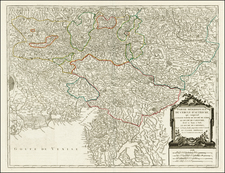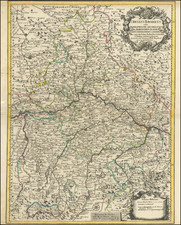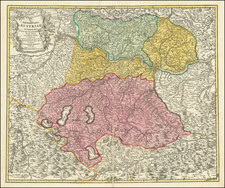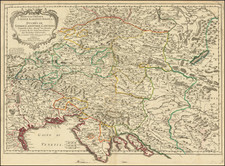Homann map of Ducal Styria. The duchy's borders extend from just west of the Mislitzbach east to Furstenfeltt (Fürstenfeld) and from Palfau south to the Sava. The area encompasses the cities and towns of Iudenburg (Judenburg), Oberwolt (Oberwölz Stadt), Leoben, Pruck (Bruck an der Mur), Voitsberg, Graz, Rackhaspurg (Bad Radkersburg), Marhburg (Maribor), Pettau (Ptuj), Windisch Weistritz (Slovenska Bistrica), Fridau (Ormož), Windisch Gratz (Slovenj Gradec), Cileia (Celje), and Rein (Brežice).
The vignette at left references the region's iron mining and shows a man wearing the ducal hat and holding the shield of Styria, set before a striking view of the mountains. The vignette at right attests to Styria's agricultural productivity, with one man reaping wheat and another tending to grapevines. Below the cartouche is a birds-eye view of the duchy's capital, Graz.
Johann Baptist Homann (1663-1724) was a mapmaker who founded the famous Homann Heirs publishing company. He lived his entire life in Bavaria, particularly in Nuremberg. Initially, Johann trained to become a priest before converting to Protestantism and working as a notary.
In 1702, Johann founded a publishing house that specialized in engravings. The firm flourished, becoming the leading map publisher in Germany and an important entity in the European map market. In 1715, Johann was named Imperial Geographer to the Holy Roman Empire by Charles VI and made a member of the Prussian Academy of Sciences. Most importantly for his business, his reputation and contacts gained him imperial printing privileges which protected his publications and recommended him to customers. Johann is best known for this Grosser Atlas ueber die ganze Welt, or the Grand Atlas of the World, published in 1716.
After Johann died in 1724, the business passed to his son, Christoph (1703-1730). Upon Christoph’s early death, the company passed to subsequent heirs, with the name of the company changing to Homann Erben, or Homann Heirs. The firm continued in business until 1848.











![[ Holy Roman Empire ] Nova Totius Germaniae Descriptio Geographica](https://storage.googleapis.com/raremaps/img/small/95672.jpg)
![[ Tribal Germany ] Germania Antiqua in IV magnos populaos in minores et minimos distincta et Regiones Danubium…1785](https://storage.googleapis.com/raremaps/img/small/97958.jpg)

